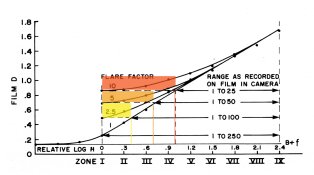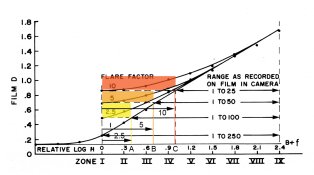markbarendt
Member
The x-axis, in my opinion, is always where things get confusing. I like to think of the increments on the x-axis of a H&D curve (regardless of how it is labelled) as relative "camera exposure settings". I think this might be analogous to what you refer to as "placement". In a zero-flare, calibrated system, actual exposure = expected exposure. When there is flare, actual exposure > expected exposure. In the lower values, densities are raised and local contrast is reduced. This is one of the problems with the typical ZS camera test in which we meter a card and stop down 4 stops.
I agree that the ZS has issues.
Overnight it clicked that "the construct" is Stephan's camera image quadrant where he is using (subject) reflectance to define the x axis scale.
The thing that was new in concept to me was that on a standard H&D curve, image compression on the straight line of the curve is possible. I had thought that the H&D curve was a better visual representation of what was happening in the image in real life than it really is.
Seeing the curve tied to the subject mater in the camera image quadrant gives me a much more relevent representation of what's happening to my print. Like the negative itself, the film's curve shape is only important as a reference guide to a storage device, a map of where it is holding the info about certain tones.




